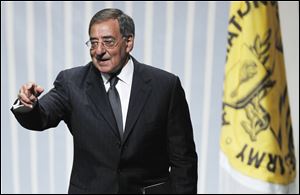
Panetta challenges Army to help define what it will look like in era of declining budgets
10/12/2011
Defense Secretary Leon Panetta addresses the Association of the U.S. Army in Washington on Wednesday.
WASHINGTON — The Army must be creative in figuring out its role when declining budgets force troop cuts and fewer missions, Defense Secretary Leon Panetta said Wednesday.
He said that as the Pentagon searches for more than $450 billion in savings over the next decade, the Army will still need to provide troops for counter-terrorism and for overseas training missions. Panetta said it must be ready at all times to stand up to a ground force, in any conventional war setting.
"This nation needs an Army that can deter any potential aggressor — an expeditionary Army able to deploy to distant battlefields and ... decisively overwhelm any enemy land force," Panetta told the annual meeting of the Association of the United States Army, a private soldier advocacy group.
"Still, the reality is there aren't a lot of countries out there building massive tank armies — it is unlikely that we will be re-fighting Desert Storm in the future," he said. Rather, Panetta said, the threat will be from groups and nations "with high-tech weaponry that is easier both to buy and to operate, weapons that frustrate our traditional advantages."
The Army of some 570,000 soldiers could be cut by nearly 50,000 by 2016, officials have said.
"Coming up with new ideas, with new operating principles to defeat (future enemies) is a challenge I pose to this battle hardened generation of American soldiers," Panetta said.
He said the U.S. needs the Army, "and particularly we need its seasoned junior leaders, to display the same creativity, the same adaptability to defeat these hybrid threats as they've shown in dealing with counterinsurgency warfare" over the past decade.
"I need you to help me figure out what the Army needs to look like for the future ... What do we need to retain in the force today to allow us to rapidly expand in the future if necessary?," he said. "What is the Army's role in a century that will present a variety of security concerns from Asia to the Middle East and beyond?"
At the same forum earlier this week, top Army leaders acknowledged that painful change is coming.
"In the past during periods of austerity we've said, 'We will have to do more with less,'" Army Chief of Staff Gen. Raymond T. Odierno told the AUSA meeting on Tuesday. "As we move ahead under significant budget restrictions, we will have to do 'less with less.'"
While he said no decisions had been made, Odierno said that over the next several months, the Army would be reviewing what he called the "force mix" that will be needed. That is, what is the correct mix of military, civilians and contractors to be used; the mix of heavy, medium and light airborne forces and the right mix of capabilities between the active force and the reserves.
Odierno said the changes will mean accepting "higher levels of risk" than Americans have in the past.
"Determining where best to do so is the primary task before us," the general said.